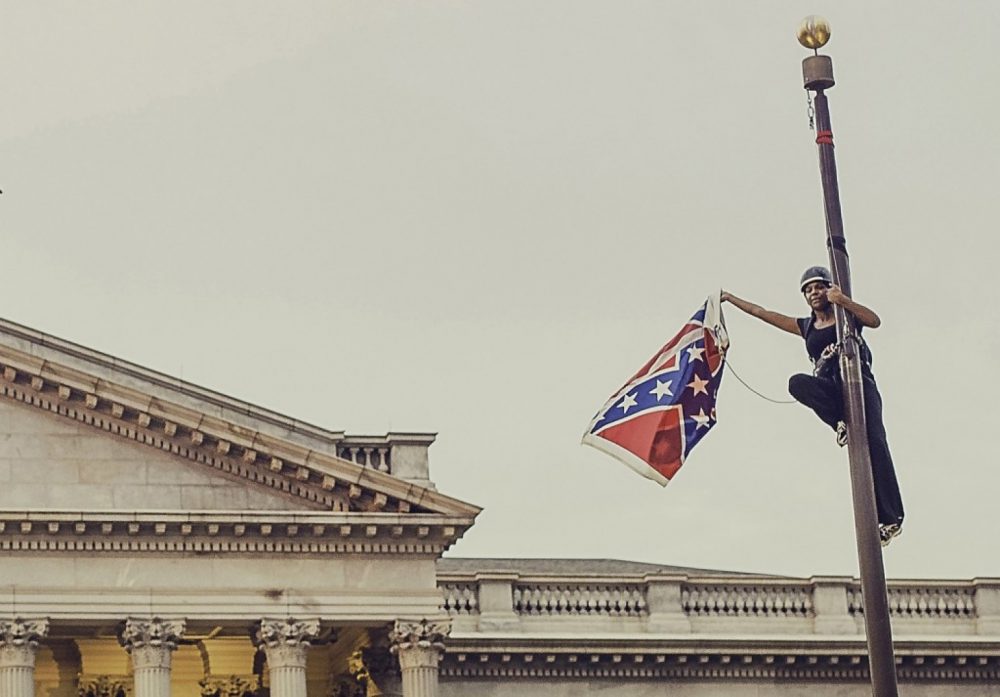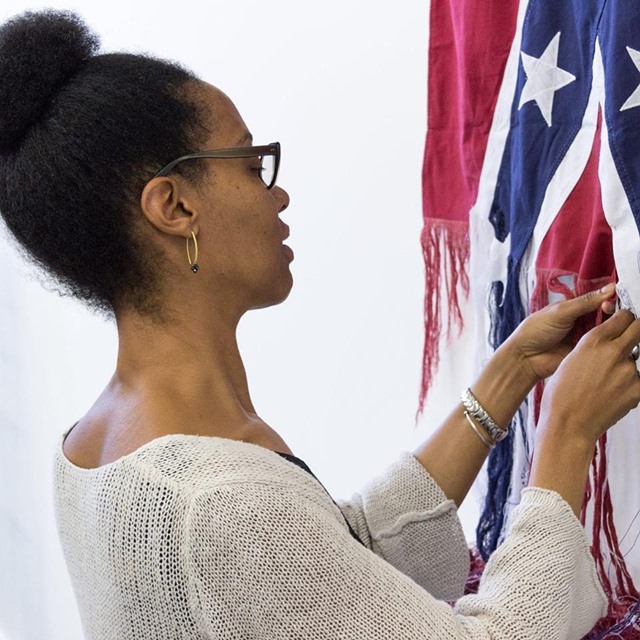That’s Not My Flag
Jessica Lynne reflects on two artists who use their practices to challenge the Confederate flag’s legacy.

Bree Newsome takes down the Confederate flag on the South Carolina State House grounds in June 2015. Photo by Reuters/Adam Anderson via the Washington Post.
As a Southerner, there are a few things with which I am intimately familiar—grits, Saturday night church revivals, and seemingly limitless humidity. Regardless of one’s dietary choices, religious affiliation, or affinity for the sweltering weather that characterizes life below the Mason-Dixon, most Southerners would agree; they’re just things that have always been, things we’ve always known.
And then there’s the Confederate flag—on bumper stickers, license plates, t-shirts, storefront windows, waving from state Capitol buildings.
It too is something we have always known. However, this is a “we” that must be qualified. For if there is anything else that Southerners are familiar with, it is the stark line of the racial divide that characterizes one’s relationship to the history of that flag. There, of course, is the “we” who would be happier if slavery was still the law of the land. There are the white folks who proclaim, however disingenuously, “Heritage, not hate!” and then there is my “we,” the black, slave-descendent “we.” Even as a child, I recognized this gulf, though I did not have the language to articulate the depths of its racial politics. The Confederate flag was not my flag.
The year 2015 felt like the reckoning. I kept asking older Southern folks, black and white, if they had ever before recalled such a public uproar over Dixie’s sacred symbol, and, for them all, the moment felt new. Certainly, there have been attempts over the years to scrub the region of this lasting visual marker of the Confederacy. Yet, last summer saw the coalescence of a contemporary resistance movement that placed the South in the center of the conversation. Perhaps it was an uproar that was inevitable. Perhaps we—my “we”—had finally had enough.
That’s what I saw when filmmaker and activist Bree Newsome climbed the flagpole on the grounds of the South Carolina State House to remove the Confederate flag that had been flying half-mast as some sort of twisted honoring of the nine men and women who were murdered at Emanuel AME Church in Charleston. She had had enough. Newsome’s takedown was a righteous, radical act not unlike the actions of the many black, Southern women who came before her, those whose names we know and those whose spirits we invoke despite not knowing their names. Newsome’s arrest after the removal of the flag sparked its own hashtag: #FreeBree. The farce of a flag was finally exposed.

Performance view of Sonya Clark’s Unravelling, 2015, at Mixed Greens, New York. Courtesy the artist via Artnet News.
Of course, artists have long been fighting at the front lines for social change. We need only look to the legacy of the Black Arts Movement to witness the ways artists have joined the charge to create a more equitable world. Poets and writers such as Sonia Sanchez and Amiri Baraka and the visual arts collective AfriCOBRA, among others, used their creative practices to assert counter-hegemonic political ideologies.
Ironically, the Confederate flag itself is the product of an artist’s eye. Because who doesn’t need smart branding? The “Stars and Bars,” the first national flag of the Confederacy, was the result of a good old-fashioned artist open call. The Confederate flag as we now know it, designed by William Porcher Miles, was originally rejected as the Southern states’ national flag in 1861. It was then adopted as the battle flag of Robert E. Lee’s Army of Northern Virginia, before being incorporated into later iterations of the Confederacy’s flag. The symbol saw a strong resurgence in the mainstream visual landscape in 1948, when the Dixiecrats assembled and nominated then South Carolina governor Strom Thurmond as the party’s presidential nominee. In 1961, South Carolina hoisted the flag atop its Capitol building to mark the centennial of the start of the Civil War. It was moved from the dome of the State House in 2000 to a nearby monument, still on the grounds, which included the flagpole Newsome scaled. I like to imagine Strom Thurmond now rolling over in his grave.
Sonya Clark is equally part of an artistic zeitgeist challenging the flag’s prominence. In Unravelling, 2015, Clark physically takes apart a Confederate flag, distressing the fabric until it is but three pools of red, blue, and white thread. Much like Newsome, Clark lives and works in a hotbed of rebel pride; she’s the Chair of the Department of Craft/Material Studies at Virginia Commonwealth University School of the Arts in Richmond, a former Confederate capital. Clark’s work reminds us that, for white supremacy to be undone, we must sweat; we must labor; we must strip it down.
The physicality of both Clark and Newsome’s disruptions illuminate the potency of symbols. Visual culture is not an abstraction. Or, to paraphrase a moment from a recent lecture given by art historian and critic Huey Copeland at the Solomon R. Guggenheim Museum in New York, political philosophies govern our visual presence(s). This presence is rooted in and governed by our socio-cultural infrastructure—in this case, structural conditions that once declared blacks to be “altogether unfit to associate with the white race, either in social or political relations; and so far inferior that they had no rights which the white man was bound to respect.”
This is the heritage of the Old South, the “we” to which I do not belong. Clark and Newsome too reject this history, pointing to the material possibilities of visual interventions that the South—all of our Souths—desperately needs.
Editor's Note
This essay originally stated that Sonya Clark’s Unravelling was “challenging the flag’s prominence in the wake of the shootings at Mother Emanuel.” Clark began her performance on April 9, 2015, and the essay has been updated to reflect this chronology.



